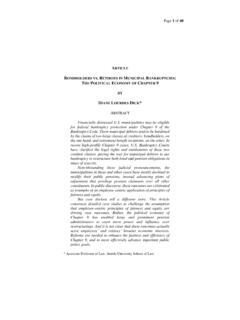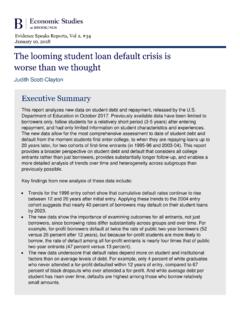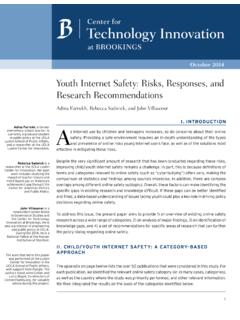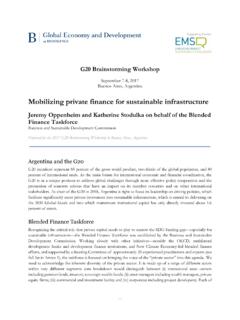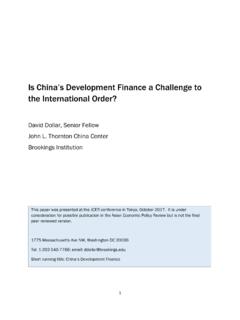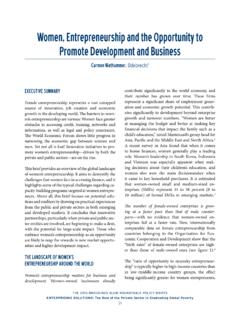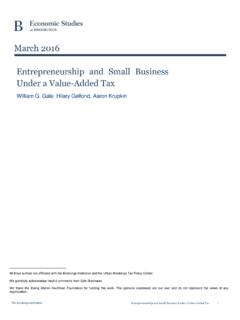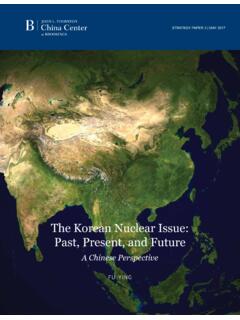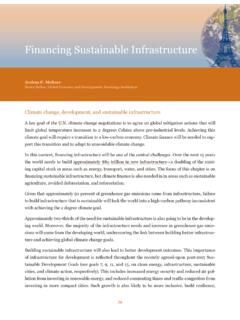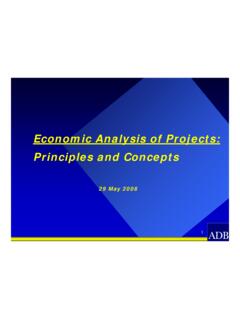Transcription of September 2014 - Quality. Independence. Impact.
1 Effects of Income Tax Changes on Economic Growth William G. Gale, The Brookings Institution and Tax Policy CenterAndrew A. Samwick, Dartmouth College and National Bureau of Economic ResearchSeptember 2014 The authors thank Fernando Saltiel, Bryant Renaud, and Aaron Krupkin for research assistance and Leonard Burman, Douglas Hamilton, Diane Lim, Donald Marron, Eric Toder, and Kevin Wu for helpful comments. This publication was made possible by a grant from the Peter G. Peterson Foundation. The statements made here and views expressed are solely those of the authors. AbstractThis paper examines how changes to the individual income tax affect long-term economic growth. The structure and financing of a tax change are critical to achieving economic growth. Tax rate cuts may encourage individuals to work, save, and invest, but if the tax cuts are not financed by immediate spending cuts they will likely also result in an increased federal budget deficit, which in the long-term will reduce national saving and raise interest rates.
2 The net impact on growth is uncertain, but many estimates suggest it is either small or negative. Base-broadening measures can eliminate the effect of tax rate cuts on budget deficits, but at the same time they also reduce the impact on labor supply, saving, and investment and thus reduce the direct impact on growth. However, they also reallocate resources across sectors toward their highest-value economic use, resulting in increased efficiency and potentially raising the overall size of the economy. The results suggest that not all tax changes will have the same impact on growth. Reforms that improve incentives, reduce existing subsidies, avoid windfall gains, and avoid deficit financing will have more auspicious effects on the long-term size of the economy, but may also create trade-offs between equity and Brookings InstitutionI. IntroductionPolicy makers and researchers have long been interested in how potential changes to the personal income tax system affect the size of the overall economy.
3 Earlier this year, for example, Representative Dave Camp (R-MI) proposed a sweeping reform to the income tax system that would reduce rates, greatly pare back subsidies in the tax code, and maintain revenue- and distributional-neutrality (Committee on Ways and Means 2014).In this paper, we focus on how tax changes affect economic growth. We focus on two types of tax changes reductions in individual income tax rates and income tax reform. We define the latter as changes that broaden the income tax base and reduce statutory income tax rates, but nonetheless maintain the overall revenue levels and the distribution of tax burdens implied by the current income system. Our focus is on individual income tax reform, leaving consideration of reforms to the corporate income tax (for which, see Toder and Viard 2014) and reforms that focus on consumption taxes for other analysis.
4 We examine impacts on the expansion of the supply side of the economy and of potential Gross Domestic Product (GDP). This expansion could be an increase in the annual growth rate, a one-time increase in the size of the economy that does not affect the future growth rate but puts the economy on a higher growth path, or both. Our focus on the supply side of the economy and the long run is in contrast to the short-term phenomenon, also called economic growth, by which a boost in aggregate demand, in a slack economy, can raise GDP and help align actual GDP with potential GDP. The importance of the topics addressed here derive from the income tax s central role in revenue generation, its impact on the distribution of after-tax income, and its effects on a wide variety of economic activities. The importance is only heightened by recent weak economic performance, concerns about the long-term economic growth rate, and concerns about the long-term fiscal status of the federal government.
5 We find that, while there is no doubt that tax policy can influence economic choices, it is by no means obvious, on an ex ante basis, that tax rate cuts will ultimately lead to a larger economy. While the rate cuts would raise the after-tax return to working, saving, and investing, they would also raise the after-tax income people receive from their current level of activities, which lessens their need to work, save, and invest. The first effect normally raises economic activity (through so-called substitution effects), while the second effect normally reduces it (through so-called income effects). In addition, if they are not financed by spending cuts, tax cuts will lead to an increase in federal borrowing, which in turn, will further reduce long-term growth. The historical evidence and simulation analysis is consistent with the idea that tax cuts that are not financed by immediate spending cuts will have little positive impact on growth.
6 On the other hand, tax rate cuts financed by immediate cuts in unproductive spending will raise output. Tax reform is more complex, as it involves tax rate cuts as well as base-broadening changes. There is a theoretical presumption that such changes should raise the overall size of the economy in the long-term, though the effect and magnitude of the impact are subject to considerable uncertainty. One fact that often escapes unnoticed is that broadening the tax base by reducing or eliminating tax expenditures raises the effective tax rate that people and firms face and hence will operate, in that regard, in a direction opposite to rate cuts. But base-broadening has the additional benefit of reallocating resources from sectors that are currently tax-preferred to sectors that have the highest economic (pre-tax) return, which should raise the overall size of the economy.
7 A fair assessment would conclude that well designed tax policies have the potential to raise economic growth, but there are many stumbling blocks along the way and certainly no guarantee that all tax changes will improve economic performance. Given the various channels through which tax policy affects growth, a growth-inducing tax policy would involve (i) large positive incentive (substitution) effects that encourage work, saving, and investment; (ii) income effects that are small and positive or are negative, including a careful targeting of tax cuts toward new economic activity, rather than providing windfall gains for previous activities; (iii) a reduction in distortions across economic sectors and across different types of income and types of consumption; and (iv) minimal increases in the budget deficit. Section II discusses the channels through which tax changes can affect economic performance.
8 Section III explores empirical evidence from major income tax changes in the United States. Section IV discusses the results from simulation models. Section V discusses cross-country evidence. Section VI of Income Tax Changes on Economic Growth 1We find that, while there is no doubt that tax policy can influence economic choices, it is by no means obvious, on an ex ante basis, that tax rate cuts will ultimately lead to a larger economy. The Brookings InstitutionII. Framework A. Reductions in income tax rates1 Reductions in income tax rates affect the behavior of individuals and businesses through both income and substitution effects. The positive effects of tax rate cuts on the size of the economy arise because lower tax rates raise the after-tax reward to working, saving, and investing. These higher after-tax rewards induce more work effort, saving, and investment through substitution effects.
9 This is typically the intended effect of tax cuts on the size of the economy. Another positive effect of pure rate cuts is that they reduce the value of existing tax distortions and induce an efficiency-improving shift in the composition of economic activity (even holding the level of economic activity constant) away from currently tax-favored sectors, such as health and housing. But pure rate cuts may also provide positive income (or wealth) effects, which reduce the need to work, save, and invest. An across-the-board cut in income tax rates, for example, incorporates all of these effects. It raises the marginal return to work increasing labor supply through the substitution effect. It reduces the value of existing tax subsidies and thus would likely alter the composition of economic activity. It also raises a household's after-tax income at every level of labor supply, which in turn, reduces labor supply through the income effect.
10 The net effect on labor supply is ambiguous. Similar effects also apply to the impact of tax rate cuts on saving and other activities. The initial tax rate will affect the impact of a tax cut of a given size. For example, if the initial tax rate on wages, say is 90 percent, a 10 percentage point reduction in taxes doubles the after-tax wage from 10 percent to 20 percent of the pre-tax wage. If the initial tax rate is 20 percent, however, the same 10 percentage point reduction in taxes only raises the after-tax wage by one eighth, from 80 percent to 90 percent of the pre-tax wage. Although income effects would be the same in the two cases, the substitution effect on labor supply and saving would be larger when tax rates are higher, so that the net gain in labor supply from a tax cut would be larger (or the net loss would be smaller in absolute value) when tax rates are high.
